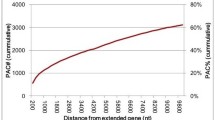Abstract
The formation of eukaryotic mRNAs involves the cleavage and polyadenylation of pre-mRNAs. To investigate the sequence requirement of putative polyadenylation signals (PASs), poly(A) sites and downstream elements (DUEs) in 3′-end-processing in rice, we compared expressed sequences tags (ESTs) with poly(A) extremity to full-length cDNA sequences and constructed a database of 12969 pre-mRNA sequences in −40–+40 nt surrounding the poly(A) sites, which were from 9953 genes. The alternative poly(A) sites were revealed in approximately 25% of mRNAs. Nearly 80% of pre-mRNAs showed stringent requirement of the YA (CA or UA) at poly (A) sites for polyadenylation. About 7.9% had the AAUAAA signals on −40–−1 nt upstream of the poly(A) sites. Over 60% of mRNAs probably used the one-or two-base variants of AAUAAA hexamers as their PASs in 3′ fragments. The single-base variants of AAUGAA revealed the high frequency in 11.5% of 3′ fragments. The DUEs were detected in 90% of pre-mRNAs, especially more than half of the pre-mRNAs with multi-base variants of AAUAAA had the DUEs surrounding the poly(A) site. The location of DUE is also important for defining the cleavage site. Although most of the rice pre-mRNAs did not contain AAUAAA signal, the existence of downstream elements ensured the efficiency of cleavage-polyadenylation
Similar content being viewed by others
References
Moore C L, Sharp P A. Accurate cleavage and polyadenylation of exogenous RNA substrate. Cell, 1985, 41: 845–855
Wichkens M. How the message got its tail addition of poly(A) in the nucleus. Trends Biochem Sci, 1990, 15: 277–281
Edwalds-Gilbert G, Veraldi K L, Milcarek C. Alternative poly(A) site selection in complex transcription units: Means to an end? Nucleic Acids Res, 1997, 25: 2547–2561
MacDonald C C, Redondo J L. Reexamining the polyadenylation signal: Were we wrong about AAUAAA? Mol Cell Endocrinol, 2002, 190: 1–8
Zarudnaya M I, Kolomiets I M, Potyahaylo A L, et al. Downstream elements of mammalian pre-mRNA polyadenylation signals: Primary, secondary and higher-order structures. Nucleic Acids Res, 2003, 31: 1375–1386
Proudfoot N. Poly(A) signals. Cell, 1991, 64: 671–674
Colgan D F, Manley J L. Mechanism and regulation of mRNA polyadenylation. Genes, 1997, 11: 2755–2766
Graber J H, Cantor C R. Mohr S C, et al. In silico detection of control signals: mRNA 3′-end-processing sequences in diverse species. Proc Natl Acad Sci USA, 1999, 96: 14055–14060
Hunt A G. Messenger RNA 3′ end formation in plants. Annu Rev Plant Physiol Plant Mol Biol, 1994, 45: 47–60
Loke J C, Stahlberg E A, Strenski D G, et al. Compilation of mRNA polyadenylation signals in Arabidopsis revealed a new signal element and potential secondary structures. Plant Physiol, 2005, 138: 1457–1468
Wu L, Ueda T, Messing J. The formation of mRNA 3′-ends in plants. Plant J, 1995, 8: 323–329
An G, Mitra A, Choi H K, et al. Functional analysis of the 3′ control region of the potato wound-inducible proteinase inhibitor II gene. Plant Cell, 1989, 1: 115–122
Chou Z F, Chen F, Wilusz J. Sequence and position requirements for uridylate-rich downstream elements of polyadenylation signals. Nucleic Acids Res, 1994, 22: 2525–2531
Chen F, MacDonald C C, Wilusz J. Cleavage site determinants in the mammalian polyadenylation signal. Nucleic Acids Res, 1995, 23: 2614–2620
Beyer K, Dandekar T, Keller W. RNA ligands selected by cleavage stimulation factor contain distinct sequence motifs that function as downstream elements in 3′-end processing of pre-mRNA. J Biol Chem, 1997, 272: 26769–26779
Kikuchi S, Satoh K, Nagata T, et al. Collection, mapping, and annotation of over 28,000 cDNA clones from japonica rice. Science, 2003, 301: 376–379
Beaudoing E, Freier S, Wyatt J R, et al. Patterns of variant polyadenylation signal usage in human genes. Genome Res, 2000, 10: 1001–1010
Beaudoing E, Gautheret D. Identification of alternate polyadenylation sites and analysis of their tissue distribution using EST data. Genome Res, 2001, 11: 1520–1526
Tian B, Hu J, Zhang H, et al. A large-scale analysis of mRNA polyadenylation of human and mouse genes. Nucleic Acids Res, 2005, 33: 201–212
Altschul S F, Madden T L, Schaffer A A, et al. Gapped BLAST and PSI-BLAST: A new generation of protein database search programs, Nucleic Acids Res, 1997, 25: 3389–3402
Marino-Ramirez L, Spouge J L, Kanga G C, et al. Statistical analysis of over-represented words in human promoter sequences. Nucleic Acids Res, 2004, 32: 949–958
Schbath S. An efficient statistic to detect over-and under-represented words in DNA sequences. J Comput Biol, 1997, 4: 189–192
Sheets M D, Ogg S C, Wickens M P. Point mutations in AAUAAA and the poly (A) addition site: Effects on the accuracy and efficiency of cleavage and polyadenylation in vitro. Nucleic Acids Res, 1990, 18: 5799–5805
Li Q, Hunt A G. A near-upstream element in a plant polyadenylation signal consists of more than six nucleotides. Plant Mol Biol, 1995, 28: 927–934
Wu L, Ueda T, Messing J. 3′-end processing of the maize 27 kDa zein mRNA. Plant J, 1993, 4: 535–544
Andrews E M, DiMaio D. Hierarchy of polyadenylation site usage by bovine papillomavirus in transformed mouse cells. J Virol, 1993, 67: 7705–7710
Aranda A, Perez-Ortin J E, Moore C, et al. Transcription termination downstream of the Saccharomyces cerevisiae FBP1 [changed from FPB1] poly(A) site does not depend on efficient 3′end processing. RNA, 1998, 4: 870
Chen J S, Nordstrom J L. Bipartite structure of the downstream element of the mouse beta globin (major) poly(A) signal. Nucleic Acids Res, 1992, 20: 2565–2572
Wahle E. 3′-end cleavage and polyadenylation of mRNA precursors. Biochim Biophys Acta, 1995, 1261: 183–194
Brown P H, Tiley L S, Cullen B R. Effect of RNA secondary structure on polyadenylation site selection. Genes Dev, 1991, 5: 1277–1284
Ahmed Y F, Gilmartin G M, Hanly S M, et al. The HTLV-I Rex response element mediates a novel form of mRNA polyadenylation. Cell, 1991, 64: 727–737
Author information
Authors and Affiliations
Corresponding author
About this article
Cite this article
Lu, Y., Gao, C. & Han, B. Sequence analysis of mRNA polyadenylation signals of rice genes. CHINESE SCI BULL 51, 1069–1077 (2006). https://doi.org/10.1007/s11434-006-1069-5
Received:
Accepted:
Issue Date:
DOI: https://doi.org/10.1007/s11434-006-1069-5




